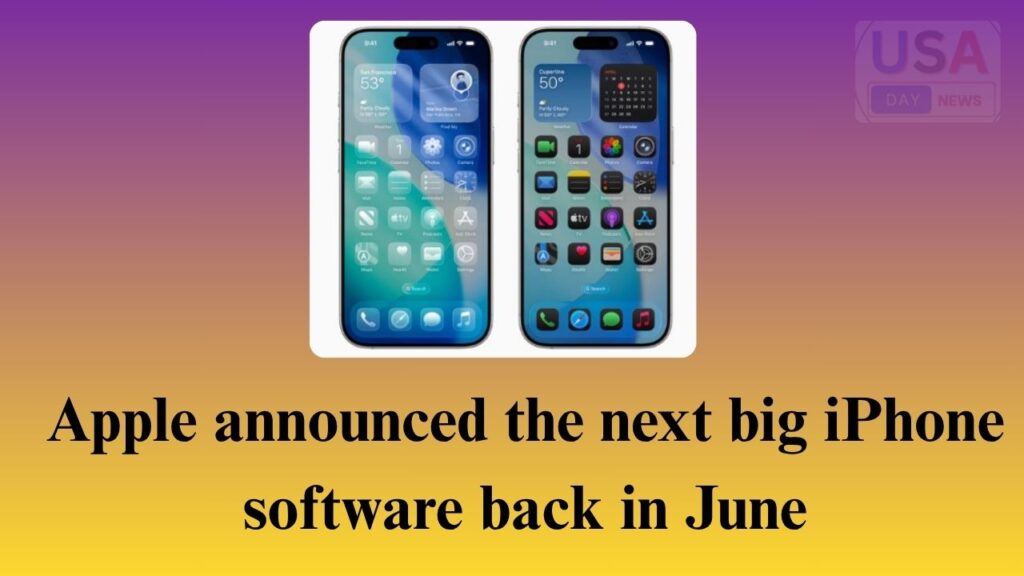Apple Announced The Next Big iPhone Software Back
Apple Announced The Next Big iPhone Software Back: As of July 2025, the very notion of an “iOS 26 Public Beta” exists firmly in the realm of science fiction and distant technological prognostication. We stand today firmly grounded in the reality of iOS 18, with its public beta freshly available to intrepid testers.
iOS 26 represents a leap nine years into the future – a timeline where the technological landscape, Apple’s strategic priorities, and the very definition of a mobile operating system could be profoundly transformed. Predicting a specific release date for such a distant iteration, especially its public beta, is less about calendar accuracy and more an exercise in understanding Apple’s rhythms and anticipating the winds of technological change. However, we can weave a tapestry of informed speculation and logical projection.
The Unshakeable Anchor: WWDC and the Annual Cadence
Apple’s development cycle for iOS is arguably one of the most predictable in the tech industry. The cornerstone is always WWDC (Apple’s Worldwide Developers Conference), typically held in early to mid-June. This event serves as the grand unveiling of the next major version of iOS (and Apple’s other operating systems). Following the keynote announcement, the very first developer previews (often unstable and feature-incomplete) are released immediately to registered developers. The Public Beta, designed for a broader audience of enthusiasts willing to test pre-release software in exchange for early access and the chance to report bugs, traditionally arrives weeks later, usually in July.
This pattern – WWDC announcement in June, Developer Betas immediately, Public Beta in July, Final Release in September alongside new iPhones – has held remarkably steady for over a decade. It’s the heartbeat of Apple’s software ecosystem. Barring unforeseen global catastrophes or a radical strategic shift from Apple (which, given their reliance on this cycle for developer readiness and hardware integration, is highly unlikely), this cadence is the primary framework for predicting any future iOS beta, including iOS 26.
Projecting the Timeline: The March Towards 2034
Assuming Apple maintains its annual major version numbering:
- iOS 18: 2024 (Announced WWDC June 2024, Public Beta July 2024)
- iOS 19: 2025 (Announced WWDC June 2025, Public Beta July 2025)
- iOS 26: 2033/2034
Counting forward, iOS 26 would logically correspond to the operating system unveiled at WWDC 2034, targeting release with the iPhone lineup in September 2034. Therefore, applying the established beta pattern:
- WWDC 2034: Early-to-Mid June 2034 (e.g., June 5th-9th). Announcement of iOS 26, macOS 31, watchOS 11, etc. Release of iOS 26 Developer Beta 1 to registered developers.
- Developer Beta Phase: Throughout June and early July, Apple releases subsequent Developer Betas (Beta 2, 3, 4…) addressing major bugs and refining features based on early feedback. This phase is crucial for stabilizing the core OS before broader testing.
- iOS 26 Public Beta Release: Based strictly on historical precedent, this would most likely land in mid-to-late July 2034. A specific, highly speculative date could be Tuesday, July 17th, 2034, or perhaps Wednesday, July 25th, 2034. This timing allows Apple to incorporate fixes from the initial developer feedback wave while still leaving a significant period (approx. 6-8 weeks) for public testing before the September final release. Expect the announcement to be a low-key blog post on the Apple Beta Software Program website, not a major event.
Beyond the Calendar: Factors Shaping the iOS 26 Beta Experience
While the timing of the public beta might be predictable, its nature is where true speculation lies. What will define the iOS 26 beta in 2034?
- The AI Crucible: By 2034, artificial intelligence won’t be a feature set; it will be the fundamental fabric of the OS. The iOS 26 beta could be the first mass public test of a truly pervasive, proactive, and deeply integrated on-device AI. Testing wouldn’t just be about app crashes, but about the reliability, ethics, and usefulness of an OS that anticipates needs, manages complex tasks autonomously, and interacts conversationally. Bug reporting might involve documenting nuanced misunderstandings or unintended consequences of AI actions.
- Spatial Computing Integration: Apple’s Vision Pro marks the beginning of a spatial computing journey. By 2034, this platform (or its successors) could be far more mature and integrated. The iOS 26 Public Beta might heavily focus on testing seamless handoff, shared experiences, and unified interfaces between iPhone, AR glasses (potentially commonplace by then), and other spatial devices. Testers might be debugging spatial interactions and contextual awareness.
- Regulatory & Security Sandbox: Increasing global regulation (DMA, potential US legislation, etc.) is already forcing Apple to open its ecosystem. By 2034, the iOS beta could involve testing radically different App Store models, deeper third-party integrations, or alternative payment systems mandated by law. Simultaneously, security threats evolve exponentially. The beta might introduce groundbreaking new privacy/security architectures requiring rigorous real-world validation against sophisticated future threats.
- Hardware Symbiosis: The iPhone of 2034 will be radically different. Think advanced flexible displays, new battery technologies (solid-state?), sophisticated multi-lens computational photography, ubiquitous sub-6GHz/mmWave/terrestrial satellite connectivity, and potentially new forms of biometrics. The iOS 26 beta will be the first public proving ground for how the software harnesses and interacts with this next-generation hardware. Testers will uncover hardware-software interaction bugs unique to these future devices.
- The Evolving Beta Program: Apple’s beta program itself might transform. Could we see more segmented betas (e.g., an “AI Preview” track)? More sophisticated automated feedback tools integrated directly into the beta OS? Incentive structures for high-quality bug reporting? The scale of testing needed for an AI-permeated, spatially-aware OS might necessitate new approaches.
The Wildcards: Could the Pattern Break?
While the June-July WWDC-to-Public-Beta rhythm is deeply ingrained, potential disruptors exist:
- Major Technological Shifts: The emergence of a truly disruptive technology (e.g., mass-market quantum computing interfaces) could force a fundamental rethink of OS architecture, potentially delaying or restructuring the beta cycle.
- Significant Regulatory Intervention: Unprecedented legal rulings forcing major, unexpected changes to iOS core functionality close to WWDC could delay the beta rollout.
- Unforeseen Global Events: Pandemics, major conflicts, or severe supply chain disruptions impacting Apple’s core operations or developer community could alter timelines, as we saw minor adjustments during the COVID-19 pandemic.
- A Shift in Apple’s Philosophy: While unlikely, if Apple decides the annual major release cycle is unsustainable or counterproductive for a vastly more complex OS, they could move to a more modular, continuous delivery model, fundamentally changing the concept of a “public beta.”
Conclusion: A Date in the Haze of Tomorrow’s Tech
The iOS 26 Public Beta Release Date, viewed through the lens of mid-2025, is most plausibly mid-to-late July 2034, anchored by the unyielding schedule of WWDC in June and the final September release. Mark your speculative calendars for a Tuesday or Wednesday around July 17th or 25th, 2034. However, the true significance lies not in the specific date, but in the unprecedented technological frontier that beta will represent. It won’t merely be a test of new apps or slightly refined interfaces.
The iOS 26 Public Beta will likely be humanity’s first large-scale, hands-on encounter with a mobile operating system deeply woven with advanced artificial intelligence, seamlessly integrated with spatial computing environments, shaped by a decade of regulatory battles, and running on hardware we can barely envision today. It will be a crucial stress test for the digital foundation of life nearly a decade from now. While the when follows a familiar pattern, the what promises to be a leap into the extraordinary. The beta testers of 2034 won’t just be finding bugs; they’ll be helping debug the future.




